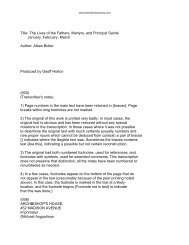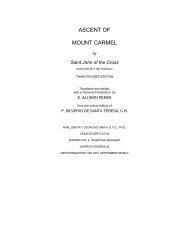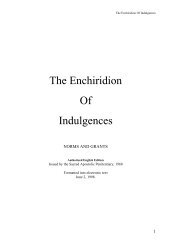Ecce Fides - Pillar of Truth - St. Patrick's Basilica
Ecce Fides - Pillar of Truth - St. Patrick's Basilica
Ecce Fides - Pillar of Truth - St. Patrick's Basilica
You also want an ePaper? Increase the reach of your titles
YUMPU automatically turns print PDFs into web optimized ePapers that Google loves.
The following provides a helpful guideline regarding author intent:<br />
1) What condition was the author confronting?<br />
2) What was the culture <strong>of</strong> the area like?<br />
3) What literary genres were common at the time?<br />
4) What modes <strong>of</strong> feeling, narrating, and speaking were common at the time?<br />
For example, the book <strong>of</strong> Revelation addresses a Church under persecution by either Nero or<br />
Domitian. The sacred author is seeking to encourage the faithful to persevere in Christ amidst great trials<br />
and tribulations. “Hold on,” “stand fast,” victory is at hand for those who remain loyal to God.<br />
The author uses symbolic and allegorical language characteristic <strong>of</strong> apocalyptic or resistance literature.<br />
Apocalyptic literature makes use <strong>of</strong> visions, animals, numbers, and cosmic catastrophes in a coded<br />
language with the express purpose <strong>of</strong> instructing the faithful in times <strong>of</strong> difficulty. The very nature <strong>of</strong><br />
apocalyptic literature--which enjoyed great popularity amongst the Jews and Christians during the first two<br />
centuries—was ideal for conveying a secret message to Christians that could not be readily understood by<br />
the enemies <strong>of</strong> Christianity.<br />
The Senses<br />
In terms <strong>of</strong> the senses <strong>of</strong> Scripture, the following are important to keep in mind.<br />
1) What is the literal meaning <strong>of</strong> the text?<br />
2) What is the spiritual sense <strong>of</strong> the text?<br />
3) What is the allegorical sense?<br />
4) What is the moral sense?<br />
5) What is the anagogical sense?<br />
In the “passion and resurrection narratives” (Mt. 26f; Mk. 14f; Lk. 22f; Jn. 18f) we have the literal<br />
reality that Jesus Christ suffered, died, and rose from the dead.<br />
In terms <strong>of</strong> the spiritual sense <strong>of</strong> these narratives we recognize that Christ’s death and resurrection was<br />
for our salvation—that in Christ we are born to eternal life. We also recognize, amongst other insights, that<br />
Christ’s death made all suffering redemptive.<br />
In terms <strong>of</strong> the allegorical sense, Jesus can be seen as the “New Moses.” Moses freed the people <strong>of</strong><br />
God from slavery and brought them to the edge <strong>of</strong> the “promised land” “flowing with milk and honey.” In<br />
a much more powerful manner, Jesus, as the new and greater Moses type or figure, freed us from the<br />
slavery <strong>of</strong> sin and brings us into the eternal bliss <strong>of</strong> heaven. Likewise, the crossing <strong>of</strong> the Red Sea by Moses<br />
is seen as being symbolic <strong>of</strong> baptism as well as a sign or type <strong>of</strong> Christ’s victory over death.<br />
As for the moral sense that can be acquired through a reading <strong>of</strong> these narratives, the insights are<br />
unending. The moral sense is intended for, as Paul states, “our moral instruction” (1 Cor. 10:11). Jesus<br />
reminds us that being moral entails the seeking and fulfilling <strong>of</strong> the will <strong>of</strong> the Father (cf. Mt. 26:39).<br />
The anagogical sense <strong>of</strong> the passion and resurrection narratives focus on realities and events in terms<br />
<strong>of</strong> their eternal significance. The resurrection <strong>of</strong> Jesus is a sign to us that we too, in him, will likewise rise<br />
and be brought into eternal glory after the end <strong>of</strong> our earthly journey. The anagogical sense is intended to<br />
guide us toward eternal life with God in heaven.<br />
The four above senses are beautifully summarized by a medieval couplet that states: “The Letter<br />
speaks <strong>of</strong> deeds; Allegory to faith; The Moral how to act; Anagogy our destiny.”<br />
The Spirit<br />
In terms <strong>of</strong> interpreting the Bible in light <strong>of</strong> the Spirit in which it was written we pursue the following<br />
rules:<br />
1) How is a particular Scripture passage understood within the context <strong>of</strong> the whole Bible?<br />
2) How is the Bible understood within the Tradition it came out from? If an interpretation <strong>of</strong> a particular<br />
passage makes a person conclude that Jesus was only a phantom or spirit, then one cannot accept this as<br />
being an authentic Tradition <strong>of</strong> the Church. One must reject this interpretation as not being faithful to the<br />
life <strong>of</strong> the Holy Spirit within the Church.<br />
3) How is the passage <strong>of</strong> the Bible understood in terms <strong>of</strong> a coherence <strong>of</strong> truths? All the doctrines <strong>of</strong> the<br />
16






